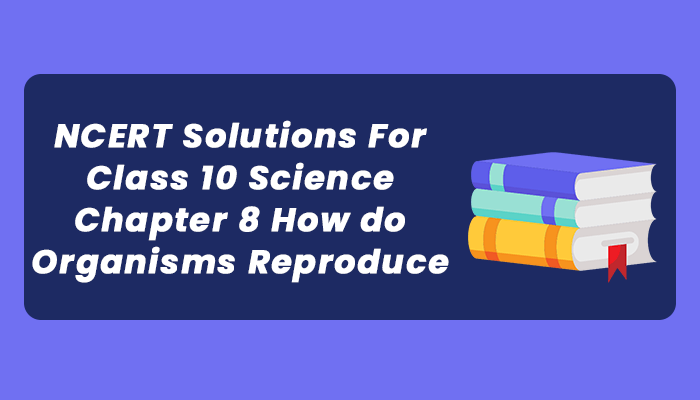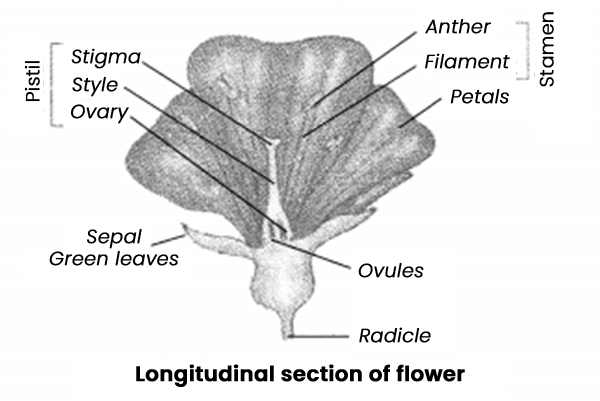NCERT Class 10 Science Solution Chapter 8 How Do Organisms Reproduce?NCERT Class 10 Science Solutions Chapter 8 How Do Organisms Reproduce: This article provides the best solution to NCERT questions with proper explanation. These solutions have been written and organized so the students can easily understand the concepts used in the answers. This way, the answers will also cover the theory part. These solutions will also help students to score better marks in their exams. 
NCERT Class 10 Science Solutions Chapter 8 Inside Book QuestionsPage Number: 128Question 1: What is the importance of DNA copying in reproduction? Answer: DNA has much importance in reproduction, and some of them are as follows: i.) DNA is responsible for maintaining the characteristics of the species. ii.) DNA marks the continuity of life. iii.) The characteristics and features of an organism are transferred to progeny through DNA. iv.) DNA is responsible for producing variations in an organism, leading to the evolution of new species. Question 2: Why is variation beneficial to the species but not necessarily for the individual? Answer: The different populations of species interact with several ecological niches. This is essential for them to survive under various conditions. When ecological circumstances inside the population are harmed, the population suffers. Resilient organisms can procreate and develop a population adapted to diverse environmental conditions. As a result, despite diversity being good for species, it is not good for people. Page Number: 133Question 1: How is the process of pollination different from fertilisation? Answer:
Question 2: How will an organism be benefited if it reproduces through spores? Answer: Because the spores are protected from dangerous conditions by a thick coating, spore reproduction is advantageous for an organism. When the correct conditions exist, these spores start to spread once more. In this way, they can endure difficult situations. Question 3: Can you think of reasons why more complex organisms cannot give rise to new individuals through regeneration? Answer: In complex multicellular creatures, specialized cells build tissues, tissues build organs, organs build organ systems, and finally, organ systems build beings. Complex multicellular creatures have extremely high levels of the organization across their whole body, making it impossible to regrow from their severed body parts. For instance, a dog's injured tail cannot be healed since the animal is a complex, multicellular creature. This is because a dog's internal organs, including the heart, brain, lungs, stomach, intestines, and limbs, cannot be developed from the cells in a dog's severed tail. Question 4: Why is vegetative propagation practised for growing some types of plants? Answer: Vegetative propagation is used for cultivating such plants, which often do not generate or produce non-viable seeds. Question 5: Why is DNA copying an essential part of the process of reproduction? Answer: To ensure that the characteristics of the parent organisms are handed down to the offspring while also producing sporadic variations, DNA replication is an essential stage in the reproduction process. Changes to an organism's DNA copy allow it to adapt to shifting environmental conditions. Page Number: 140Question 1: How is the process of pollination different from fertilisation? Answer:
Question 2: What is the role of the seminal vesicles and the prostate gland? Answer: Role of seminal vesicles and prostate gland are as follows: i.) Seminal vesicles and prostate gland secrete a fluid part of semen. These fluids make the path smooth so that the sperms can travel easily. The fluid secreted by seminal vesicles constitutes 60 percent of the semen, while the fluid of the prostate gland forms 30 percent of the semen. ii.) These fluids are also responsible for protecting sperms from the acids present in the urethra. iii.) This fluid also acts as a food source for the sperms in the form of calcium, some enzymes, and fructose. Question 3: What are the changes seen in girls at the time of puberty? Answer: The many changes that take place in girls throughout puberty include: 1.) Hair grows in the pubic and underarm areas. 2.) Breasts or mammary glands grow and develop. 3.) The hips expand. 4.) Extra fat is stored in many bodily regions, such as the hips and thighs. 5.) The uterus, fallopian tube, and vagina expand. 6.) Egg release from the ovaries begins. 7.) Start of menstruation (monthly periods). 8.) Emotional and sexual urges linked with maturity start to emerge. Question 4: How does the embryo get nourishment inside the mother's body? Answer: The embryo inside the mother's body gets all its nutrition from the mother's blood. This is achieved through a special structure known as the placenta, which contains a villi structure. The empty spaces inside the mother's tissue cover these villi, which provide a large surface area and thus help transfer all kinds of nutrients like oxygen, glucose, and any other substance the embryo may require. Question 5: A woman is using a copper-T. Will it help in protecting her from sexually transmitted diseases? Answer: A method of birth control known as copper-T prevents the zygote from implanting inside the uterus. Copper-T cannot prevent the transmission of these diseases through physical contact. Infections brought on by sex cannot be avoided in females. NCERT Solutions for Class 10 Science Chapter 8 Exercise QuestionsQuestion 1: Asexual reproduction takes place through budding in
Answer: b.) Yeast Question 2: Which of the following is not a part of the female reproductive system in human beings?
Answer: c.) Vas deferens Question 3: The anther contains a.) sepals b.) ovules c.) carpel d.) pollen grains Answer: d.) Pollen grains Question 4: What are the advantages of sexual reproduction over asexual reproduction? Answer: Advantages of sexual reproduction over asexual reproduction are as follows: i.) Because they share their parent's DNA, the children of asexual reproduction are almost similar to their parents. Therefore, asexual reproduction cannot produce a great deal of genetic variation. This is a drawback since it prevents the organism from evolving further. ii.) Although the children of sexual reproduction are similar to their parents, they are not genetically identical to either of them or one another. This is so that the children can inherit the mother's and the father's DNA equally. All children have diverse genetic makeups since the mother's and father's DNA are mixed in different proportions. The population becomes more diverse as a result of sexual reproduction. This indicates that an animal or plant species can swiftly adapt to environmental changes. This is because certain people will always be more adapted to the changes than others, and these people will survive and reproduce. Question 5: What are the functions performed by the testis in human beings? Answer: The functions of testes in humans are following : i.) Human male testes generate male gametes, often known as sperms, after the teenage stage. ii) The testes are where testosterone, a hormone, is created. The growth of reproductive organs and secondary sexual characteristics are regulated by testosterone. Question 6: Why does menstruation occur? Answer: The thick and delicate inner lining of the uterus tears if the ovum (or egg) does not become fertilized (due to the lack of sperm in the female body). Therefore, menstruation is the process by which the blood-filled vaginal cavity is filled with the thick and soft inner lining of the uterus, blood vessels, and the dead ovum (or egg). Every 28 days, menstruation occurs; the gap between ovulation and menstruation is around 14 days. The uterus's thick and delicate inner lining cracks if the ovum (or egg) does not become fertilized (due to insufficient sperm in the female body). So, during menstruation, blood in the form of the thick and soft inner lining of the uterus, blood vessels, and the dead ovum (or egg) flow out of the vagina. DNA replication is a crucial step in the reproduction process because it ensures that the traits of the parent organisms are passed on to the offspring while simultaneously causing random variants. An organism may adapt to changing environmental conditions by changing its DNA copy. DNA replication is a crucial step in the reproduction process because it ensures that the traits of the parent organisms are passed on to the offspring while simultaneously causing random variants. An organism may adapt to changing environmental conditions by changing its DNA copy. Question 7: Draw a labelled diagram of the longitudinal section of a flower. Answer: Longitudinal section of a flower. 
Question 8: What are the different methods of contraception? Answer: The different methods of contraception are as follows: i.) Barrier method: The barrier technique employs cervical caps, diaphragms, and condoms. These stop sperm from entering the female vaginal canal during sexual activity. ii.) Chemical technique: A lady utilizes two types of tablets in this procedure (oral and vaginal pills). The hormone supplements taken orally prevent the release of the ovum from the fallopian tube. We refer to them as oral contraceptives. Spermicidal tablets and lotions are used vaginally. The chemicals kill the sperm in these spermicidal as they travel through the vaginal system. iii.) Intrauterine contraceptive devices: Intrauterine contraceptive devices, such as copper-T, are inserted securely into the uterus by a trained medical professional. It stops the sperm from getting to the uterus. iv.) Surgical technique: A small portion of the female fallopian tube and the male vas deferens are surgically cut or knotted. It is known as vasectomy for men, and for females, it is a tubectomy. Question 9: How are the modes for reproduction different in unicellular and multicellular organisms? Answer:
Question 10: How does reproduction help in providing stability to populations of species ? Answer: The insertion of variants during reproduction stabilizes populations of different species by keeping them from going extinct under difficult circumstances. Additionally, reproduction aids in creating duplicates of people who are adapted to a certain environment. Question 11: What could be the reasons for adopting contraceptive methods ? Answer: The reasons for adopting contraceptive devices are as follows: i.) Contraceptive devices help control the birth rate, which in turn helps prevent a population increase. ii.) It protects a mother's body by preventing frequent pregnancy. iii.) It is also helpful in preventing STDs, i.e., sexually transmitted diseases.
Next TopicClass 10 Science Chapter 9
|
 For Videos Join Our Youtube Channel: Join Now
For Videos Join Our Youtube Channel: Join Now
Feedback
- Send your Feedback to [email protected]
Help Others, Please Share









